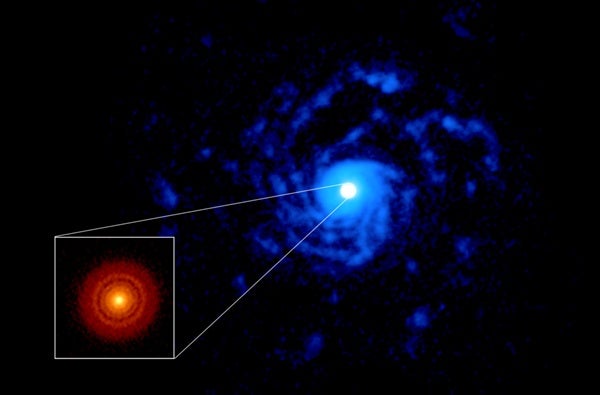Spiral disk
The center of this so-called “mini-galaxy” extends some 60 astronomical units (AU), which is about twice the diameter of Neptune’s orbit. And thought that might seem large at first blush, the mini-galaxy’s arms stretch out to nearly 1,000 AU.
Astronomers had previously observed RU Lup using the Atacama Large Millimeter/submillimeter Array (ALMA), which indicated unusual gas structures extending beyond the disk. “That’s why we decided to observe the disk around the star again, this time focusing on the gas instead of the dust,” astronomer and lead author Jane Huang of the Center for Astrophysics said in an NRAO press release. “[This find] suggests that we have likely not seen the full diversity and complexity of planet-forming environments.”
ALMA’s high-resolution images of protoplanetary disks around young stars have revolutionized scientists’ understanding of how planets form. But this new image highlights there’s a lot they still don’t know. If other stars host similar extended protoplanetary disks, it would indicate that planet formation is far more chaotic than previously thought.
How to form a “planet galaxy”
As for how the spiral arms were created, Huang and her team suggest a few ideas in their paper, published August 3 in The Astrophysical Journal.
They say it’s possible that the disk is too massive — unsurprising given its extreme reach — and may be collapsing under its own gravity. Determining exactly how much mass the disk contains is difficult, but the its luminosity indicates it’s one of the most massive such disks in the region.
Alternatively, RU Lup may have an unseen companion — either a second star or an extremely massive planet. Such an interloper could explain the disk’s spiraled ripples, the researchers say. While not the most likely explanation stunning arms around RU Lup, using the Very Large Telescope, some scientist think that an exoplanet twice the mass of Jupiter might be orbiting the star at 200 AU.
Alone, however, none of the scenarios completely explain the observations. “There might be unknown processes happening during planet formation that we have not yet accounted for in our models,” said co-author Sean Andrews. “We will only learn what they are if we find other disks out there that look like RU Lup.”










